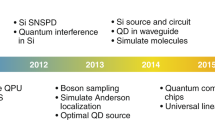
Overview
- Employs a unique pedagogical approach to the fundamentals of quantum photonics
- Addresses a broad audience in physics, optoelectronics and materials science
- Expanded second edition includes treatment of electrons as fermions with their own operator algebra
- Supported by numerous numerical calculations that can be practiced by the reader
- Gives guidance to determining precise properties and behavior of photonic materials and devices through numerical modelling
Part of the book series: Graduate Texts in Physics (GTP)
Access this book
Tax calculation will be finalised at checkout
Other ways to access
About this book
Photonics is the discipline of electrons and photons working in tandem to create new physics, new devices and new applications. This textbook employs a pedagogical approach that facilitates access to the fundamentals of quantum photonics. Beginning with a review of the quantum properties of photons and electrons, the book then introduces the concept of their non-locality at the quantum level. It presents a determination of electronic band structure using the pseudopotential method, enabling the student to directly compute the band structures of most group IV, group III-V, and group II-VI semiconductors. The book devotes further in-depth discussion of second quantization of the electromagnetic field that describes spontaneous and stimulated emission of photons, quantum entanglement and introduces the topic of quantum cascade lasers, showing how electrons and photons interact in a quantum environment to create a practical photonic device.
This extended second editionincludes a detailed description of the link between quantum photon states and the macroscopic electric field. It describes the particle qualities of quantum electrons via their unique operator algebra and distinguishable behavior from photons, and employs these fundamentals to describe the quantum point contact, which is the quantum analogue of a transistor and the basic building block of all nanoscopic circuits, such as electron interferometers.
Similar content being viewed by others
Keywords
Table of contents (11 chapters)
-
Front Matter
-
Back Matter
Reviews
“Pearsall has merged most modern quantum devices, and quantum information with semiconductor physics. The chapter topics include electromagnetic field quantization, giving rise to spontaneous parametric down conversion, and multi-photon entanglement. There is also Bell’s theorem, local reality, and hidden variables. Each chapter has homework exercises making the book valuable for a course at the 1st year graduate level. A unique feature is that Pearsall presents a diorama of free-electron semiconductor bandstructure evolving into the actual band-structure as the pseudo-potentials are turned on 10 successive steps. He presents this for the 3 most important cases, Si, Ge, and GaAs. This is terrific for students. This book is very much needed, and covers the topics that students will care about in the coming years.” (Prof. Eli Yablonovitch, Department of Electrical Engineering, University of California, Berkeley)
“Quantum photonics is a welcome addition to graduate physics textbooks: it explores a number of topics that have become important in recent years, and for which it is very useful to find here a basic and pedagogical presentation. I especially liked the parallel treatments of quantum photons and quantum electrons. Instead of searching in the literature for separate entries, one finds here the main ideas for both bosons and fermions placed side by side, and explained in a very straightforward way. The book has also been very handy to introduce student trainees to various topics, such as two-dimensional electrons and modulation doping.” (Ulf Gennser, Centre for Nanoscience and Nanotechnology, France)
“I enjoyed reading the chapter on pseudopotenial band structure calculations very much. It is difficult to make the step from the abstract equation to plotting the band structure using the pseudopotential method by writing your own code. With the help of the provided Matlab script, I was able to comprehend the method. The topic is difficult because many semiconductor books hide important details, such as presenting the algorithm as such. I think it is very helpful nowadays having books that come with scripts so that the readers can reproduce the plots. I have used this script and the lecture material on band structure calculations in my Quantum Physics Lecture at the Hochschule München.” (Stefan Birner, nextnano GmbH)
“This book contains a rather unique, yet highly useful combination of topics. Starting from the behavior of electrons is semiconductor heterostructures, it extends to laser physics and quantum optics, focusing on the relevant properties for the “second quantum revolution”, whose applications we face today in quantum information technology. Relevant experiments on quantum interference are discussed both for photons and electrons, accompanied by a theoretical description using second quantization. All calculations are easy to follow also for experimentalists. Overall this is a very timely book on the physics necessary to understand semiconductor based quantum photonic devices. In addition it is a pleasure to read, offering also new perspectives on various topics.” (Prof. Dr. Manfred Helm, Director, Institute of Ion Beam Physics and Materials Research, Helmholtz-Zentrum Dresden-Rossendorf (HZDR))Authors and Affiliations
About the author
In 2003, Pearsall started EPIC, The European Photonics Industry Consortium, which has been a leading contributor to the launch and the development of the European Technology Platform Photonics21. He is a Fellow of the American Physical Society and a Fellow of the IEEE.
Bibliographic Information
Book Title: Quantum Photonics
Authors: Thomas P. Pearsall
Series Title: Graduate Texts in Physics
DOI: https://doi.org/10.1007/978-3-030-47325-9
Publisher: Springer Cham
eBook Packages: Physics and Astronomy, Physics and Astronomy (R0)
Copyright Information: The Editor(s) (if applicable) and The Author(s), under exclusive license to Springer Nature Switzerland AG 2020
Hardcover ISBN: 978-3-030-47324-2Published: 05 January 2021
Softcover ISBN: 978-3-030-47327-3Published: 06 January 2022
eBook ISBN: 978-3-030-47325-9Published: 04 January 2021
Series ISSN: 1868-4513
Series E-ISSN: 1868-4521
Edition Number: 2
Number of Pages: XVII, 367
Number of Illustrations: 103 b/w illustrations, 83 illustrations in colour
Topics: Quantum Optics, Optics, Lasers, Photonics, Optical Devices, Microwaves, RF and Optical Engineering, Optical and Electronic Materials, Nanoscale Science and Technology



